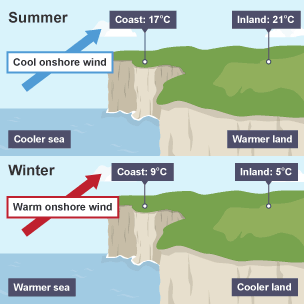Class 7 Social Science Chapter 3 HOTS Questions - Climates of India
Q1: How do climate factors like latitude, altitude, and proximity to the sea affect the temperature and lifestyle of people in different regions of India?
Ans:
- Latitude, altitude, and proximity to the sea significantly impact temperature and lifestyle.
- For instance, areas near the Equator, like Kanyakumari, remain warm throughout the year due to the direct sunlight.
- In contrast, places at higher altitudes, like Shimla, experience cooler temperatures because the air is thinner and farther from the Earth's warmth.
- Coastal areas, such as Mumbai, have moderate temperatures, as the sea keeps the summers cooler and winters warmer.
- These factors influence people’s clothing, agricultural practices, and even the types of crops they grow in different regions.
 Proximity to Sea
Proximity to SeaQ2: Compare the climate of the Thar Desert and the Western Coast of India in terms of rainfall and temperature variations.
Ans:
- The Thar Desert has an arid climate, with very high temperatures during the day and cool nights due to minimal rainfall.
- The region experiences extreme temperature variations, with summer temperatures often exceeding 40°C and winters dipping to near freezing levels.
- In contrast, the Western Coast has a tropical wet climate, with heavy monsoon rainfall that supports rice and spice cultivation.
- The temperature remains moderate throughout the year due to the moderating effect of the sea, with summer temperatures around 32°C and winter temperatures not dropping significantly.
Q3: How would you plan a crop rotation strategy for a farm in the Northern Plains, taking into account the region's climate and seasons?
Ans:
- In the Northern Plains, where the climate is subtropical with hot summers and cold winters, I would plan a crop rotation strategy that includes winter crops like wheat, which grow well in the cooler months, and summer crops like rice, which thrive in the warmer temperatures.
- The monsoon season would bring necessary rainfall, so I would plant crops like rice that require heavy rain.
- After the monsoon, I would rotate with drought-resistant crops or those that can survive in cooler, dry conditions, such as barley or legumes, to prevent soil depletion.
Q4: If you were a policy maker in a state affected by frequent cyclones, what steps would you take to protect people and minimize damage from future cyclones?
Ans:
- As a policy maker, I would first focus on improving early warning systems and ensuring that the India Meteorological Department (IMD) provides timely and accurate cyclone alerts.
- I would also prioritize the construction of cyclone-resistant infrastructure and the development of evacuation plans for coastal populations.
- Public awareness campaigns about cyclone preparedness and creating cyclone shelters would be essential.
- Additionally, I would promote sustainable land use practices to prevent erosion and increase the resilience of the environment to withstand future storms.
Q5: Do you think the traditional knowledge of predicting monsoons is still relevant today? Justify your answer.
Ans:
- Yes, traditional knowledge of predicting monsoons remains relevant today as it is based on centuries of observation of natural signs.
- For example, signs like fish surfacing on the Konkan coast or the blooming of Golden Shower trees have been reliable indicators of the monsoon's arrival.
- While modern weather forecasting has advanced, traditional knowledge still plays a crucial role in communities with limited access to technology.
- It provides a backup system and reinforces local cultural ties to nature.
Q6: What would happen to agriculture in India if the monsoon season were to fail for two consecutive years?
Ans:
- If the monsoon season were to fail for two consecutive years, it would lead to severe water shortages, particularly in regions dependent on rainfall for irrigation, such as the Northern Plains.
- Crops like rice, which require consistent rainfall, would fail, leading to food shortages.
- This would result in an economic crisis, as agriculture is a major contributor to India’s GDP.
- The failure of the monsoon would also lead to increased food prices, unemployment in rural areas, and a potential migration of workers to urban centers in search of livelihood.
Q7: Design an educational campaign to teach students about the importance of understanding climate and its effect on agriculture.
Ans:
- The campaign would include interactive workshops that explain how different climate factors, like temperature and rainfall, impact crops.
- I would use visual aids like maps, weather charts, and videos to show the effects of climate on crop growth and yield.
- Students would participate in hands-on activities such as creating weather journals to track seasonal changes and learning about the science behind farming in different climates.
- The campaign would also include field trips to farms and invite farmers to discuss how they adapt to changing climates.
- The goal would be to raise awareness about the importance of climate knowledge for sustainable agriculture.
|
23 videos|274 docs|12 tests
|
FAQs on Class 7 Social Science Chapter 3 HOTS Questions - Climates of India
| 1. What are the different seasons experienced in India? |  |
| 2. How does the geographical location of India affect its climate? |  |
| 3. What is the significance of the monsoon season in India? |  |
| 4. How do climate variations impact the lifestyle of people in India? |  |
| 5. What are the effects of climate change on India's climate? |  |





















